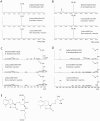Reconstitution of the costunolide biosynthetic pathway in yeast and Nicotiana benthamiana
- PMID: 21858047
- PMCID: PMC3156125
- DOI: 10.1371/journal.pone.0023255
Reconstitution of the costunolide biosynthetic pathway in yeast and Nicotiana benthamiana
Abstract
The sesquiterpene costunolide has a broad range of biological activities and is the parent compound for many other biologically active sesquiterpenes such as parthenolide. Two enzymes of the pathway leading to costunolide have been previously characterized: germacrene A synthase (GAS) and germacrene A oxidase (GAO), which together catalyse the biosynthesis of germacra-1(10),4,11(13)-trien-12-oic acid. However, the gene responsible for the last step toward costunolide has not been characterized until now. Here we show that chicory costunolide synthase (CiCOS), CYP71BL3, can catalyse the oxidation of germacra-1(10),4,11(13)-trien-12-oic acid to yield costunolide. Co-expression of feverfew GAS (TpGAS), chicory GAO (CiGAO), and chicory COS (CiCOS) in yeast resulted in the biosynthesis of costunolide. The catalytic activity of TpGAS, CiGAO and CiCOS was also verified in planta by transient expression in Nicotiana benthamiana. Mitochondrial targeting of TpGAS resulted in a significant increase in the production of germacrene A compared with the native cytosolic targeting. When the N. benthamiana leaves were co-infiltrated with TpGAS and CiGAO, germacrene A almost completely disappeared as a result of the presence of CiGAO. Transient expression of TpGAS, CiGAO and CiCOS in N. benthamiana leaves resulted in costunolide production of up to 60 ng.g(-1) FW. In addition, two new compounds were formed that were identified as costunolide-glutathione and costunolide-cysteine conjugates.
Conflict of interest statement
Figures







Similar articles
-
Cytochrome P450s from Cynara cardunculus L. CYP71AV9 and CYP71BL5, catalyze distinct hydroxylations in the sesquiterpene lactone biosynthetic pathway.Plant Sci. 2014 Jun;223:59-68. doi: 10.1016/j.plantsci.2014.03.007. Epub 2014 Mar 13. Plant Sci. 2014. PMID: 24767116
-
A chicory cytochrome P450 mono-oxygenase CYP71AV8 for the oxidation of (+)-valencene.FEBS Lett. 2011 Jan 3;585(1):178-82. doi: 10.1016/j.febslet.2010.11.040. Epub 2010 Nov 26. FEBS Lett. 2011. PMID: 21115006
-
Biosynthesis of costunolide, dihydrocostunolide, and leucodin. Demonstration of cytochrome p450-catalyzed formation of the lactone ring present in sesquiterpene lactones of chicory.Plant Physiol. 2002 May;129(1):257-68. doi: 10.1104/pp.010957. Plant Physiol. 2002. PMID: 12011356 Free PMC article.
-
Germacrene A-A Central Intermediate in Sesquiterpene Biosynthesis.Chemistry. 2020 Dec 23;26(72):17318-17341. doi: 10.1002/chem.202002163. Epub 2020 Sep 30. Chemistry. 2020. PMID: 32442350 Free PMC article. Review.
-
Recent advances in lycopene and germacrene a biosynthesis and their role as antineoplastic drugs.World J Microbiol Biotechnol. 2024 Jun 25;40(8):254. doi: 10.1007/s11274-024-04057-0. World J Microbiol Biotechnol. 2024. PMID: 38916754 Review.
Cited by
-
CRISPR/Cas9 targeted inactivation of the kauniolide synthase in chicory results in accumulation of costunolide and its conjugates in taproots.Front Plant Sci. 2022 Aug 29;13:940003. doi: 10.3389/fpls.2022.940003. eCollection 2022. Front Plant Sci. 2022. PMID: 36105709 Free PMC article.
-
Kauniolide synthase is a P450 with unusual hydroxylation and cyclization-elimination activity.Nat Commun. 2018 Nov 7;9(1):4657. doi: 10.1038/s41467-018-06565-8. Nat Commun. 2018. PMID: 30405138 Free PMC article.
-
Plant Engineering to Enable Platforms for Sustainable Bioproduction of Terpenoids.Methods Mol Biol. 2024;2760:3-20. doi: 10.1007/978-1-0716-3658-9_1. Methods Mol Biol. 2024. PMID: 38468079 Review.
-
Insights into the Sesquiterpenoid Pathway by Metabolic Profiling and De novo Transcriptome Assembly of Stem-Chicory (Cichorium intybus Cultigroup "Catalogna").Front Plant Sci. 2016 Nov 8;7:1676. doi: 10.3389/fpls.2016.01676. eCollection 2016. Front Plant Sci. 2016. PMID: 27877190 Free PMC article.
-
Biosynthesis and bioactivity of anti-inflammatory triterpenoids in Calendula officinalis.Nat Commun. 2025 Jul 28;16(1):6941. doi: 10.1038/s41467-025-62269-w. Nat Commun. 2025. PMID: 40721615 Free PMC article.
References
-
- Rodriguez E, Towers GHN, Mitchell JC. Biological-activies of sesquiterpene lactones. Phytochemistry. 1976;15:1573–1580.
-
- Zhang S, Won YK, Ong CN, Shen HM. Anti-cancer potential of sesquiterpene lactones: bioactivity and molecular mechanisms. Curr Med Chem Anticancer Agents. 2005;5:239–249. - PubMed
-
- Lyss G, Knorre A, Schmidt TJ, Pahl HL, Merfort I. The anti-inflammatory sesquiterpene lactone Helenalin inhibits the transcription factor NF-κB by directly targeting p65. Journal of Biological Chemistry. 1998;273:33508–33516. - PubMed
-
- Koo TH, Lee J-H, Park YJ, Hong Y-S, Kim HS, et al. A sesquiterpene lactone, costunolide, from Magnolia grandiflora inhibits NF-κB by targeting IκB phosphorylation. Planta Med. 2001;67:103–107. - PubMed
-
- Klayman DL. Qinghaosu (Artemisinin) - an antimalarial drug from China. Science. 1985;228:1049–1055. - PubMed
Publication types
MeSH terms
Substances
Associated data
- Actions
LinkOut - more resources
Full Text Sources
Other Literature Sources

